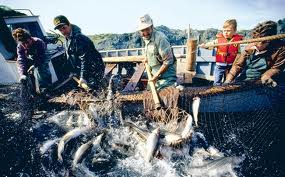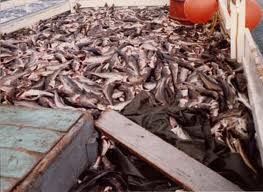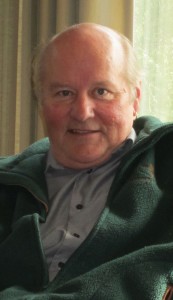By Ray Rivers.
BURLINGTON, ON. They are romantic little fishing villages dotting the coastline of this Island province, the last to join Canada. The quaint, brightly painted houses and boat shacks are all well maintained and clean. It is as if the clock had been turned back a half century or more – except for the quiet. An eerie silence pervades, almost like being in an episode of the Twilight Zone. Perhaps it just seems that way because the sea is empty. There are no boats in the harbours; nobody selling their catch-of-the-day on the docks; no seagulls dodging and diving for discarded fish guts; and nobody fishing off an island that was founded on the cod fish.

The cod almost jumped out of the water and into the boats. It was a phenomenal resource that sustained a province – until the bureaucrats got the numbers wrong.
The almighty cod fish which attracted settlers and fishers from all around the world; which led to the discovery of Newfoundland; and that provided the income and livelihood for its inhabitants… is gone. The cod fishery collapsed in the late 1980‘s, though it took the federal government until 1992 to actually declare a total moratorium. Thirty thousand workers lost their jobs overnight and now Newfoundlanders are allowed only a three-week window to catch a few lonely cod for their own tables.
The expert government scientists really blew this one. They over-estimated the cod stock, underestimated the impact of the fishing vacuum cleaners, called factory trawlers, and then nodded politely as their masters applied political pressure to keep the fishery open, long after it should have been closed. Now, over two decades later the stock has still not recovered. Locals do express hope for the cod, some optimism, unlike they do for the wild Atlantic salmon which is truly gone forever.
Thank God we have agriculture. But now we have more expert scientists guiding our policy makers, as they support Monsanto and other companies creating the new and exciting genetically modified organisms (GMO). It was only1994, less than two decades ago, when the first commercially available GMO food, a tomato, was approved by the US FDA. Yet today there are 25 GMO plants being grown around the world, and almost all of the corn and soybeans (90%) grown in the US are GMO. Canada is not far behind this trend.
Some of the genetic material spliced into these foods simply allows the plants to defend themselves against pesticides like Monsanto’s Round-up, which does such a deadly job of cleaning up the weeds. Some GMOs have altered biological processes, such as the tomato, which now ripens slower than nature had intended – keeping it fresher-looking on the grocer’s shelf. And the latest GMO being developed claims to enhance the nutritional value of food (golden rice), thus offering the promise of feeding the masses being born into hunger in the less developed nations of the world.
 The remaining category of GMO foods actually contain pesticides within their DNA, such as bt corn and bt potatoes . Every time we eat these foods we intake the same pesticide DNA that kills or wards off predatory insects, fungal diseases, etc. Now the agriculture and health agencies and their scientists tell us that these products are safe. But I worry that, like the fisheries experts, they are missing something and haven’t grasped the bigger picture – and that we should be moving slower and more cautiously. GMOs have been critically labelled ‘franken foods’ by the organic industry because their process of gene splicing is unlike anything which occurs in nature.
The remaining category of GMO foods actually contain pesticides within their DNA, such as bt corn and bt potatoes . Every time we eat these foods we intake the same pesticide DNA that kills or wards off predatory insects, fungal diseases, etc. Now the agriculture and health agencies and their scientists tell us that these products are safe. But I worry that, like the fisheries experts, they are missing something and haven’t grasped the bigger picture – and that we should be moving slower and more cautiously. GMOs have been critically labelled ‘franken foods’ by the organic industry because their process of gene splicing is unlike anything which occurs in nature.
I confess, I used to be an organic producer and I managed an organic certification agency here in Ontario – so that is my bias. Like others, committed to organic foods, I am concerned about how much testing has gone into these GMO products, given how soon after development we move these foods into production, the market place and our stomachs. What if we discover a problem in due course, will we have enough non-GMO seeds to change back? I am annoyed that there is no labeling where we purchase food, informing us whether we are getting GMO, thus purposely blocking us from exercising our rights to choice as consumers. And I do worry about the cumulative effect of eating foods with poison in their genetic make-up.
 Once, I ran out of soybean seeds for some garden-variety edamame I was planting. Rushed, I inquired about organic seeds at my local farmers’ supply store. But the only kind they had were ‘Round-up Ready’ by Monsanto. These seeds came with a contract I needed to sign confirming that, though I bought and grew them, they were Monsanto property into perpetuity. I just shook my head and contacted an organic grower to help me out.
Once, I ran out of soybean seeds for some garden-variety edamame I was planting. Rushed, I inquired about organic seeds at my local farmers’ supply store. But the only kind they had were ‘Round-up Ready’ by Monsanto. These seeds came with a contract I needed to sign confirming that, though I bought and grew them, they were Monsanto property into perpetuity. I just shook my head and contacted an organic grower to help me out.

There was nothing modified about this natural resource. All we had to do was responsibly preserve and wisely harvest. We failed to do that.
I know our agricultural scientists are well-educated and have our best interests at heart when they tell us they believe that GMOs are safe – and time may well prove them to be right. But then I think back to those meetings with the well-respected federal fisheries biologists, when we used to finalize and allocate fishing quotas. They were convinced that the northern cod stock was strong and growing, and that despite all the fishing pressure it was facing, would never collapse.
 Ray Rivers was born in Ontario; earned an economics degree at the University of Western Ontario and earned a Master’s degree in economics at the University of Ottawa. His 25 year stint with the federal government included time with Environment, Fisheries and Oceans, Agriculture and the Post office. Rivers is active in his community; has run for municipal and provincial office and held executive positions with Liberal Party riding associations. He developed the current policy process for the Ontario Liberal Party.
Ray Rivers was born in Ontario; earned an economics degree at the University of Western Ontario and earned a Master’s degree in economics at the University of Ottawa. His 25 year stint with the federal government included time with Environment, Fisheries and Oceans, Agriculture and the Post office. Rivers is active in his community; has run for municipal and provincial office and held executive positions with Liberal Party riding associations. He developed the current policy process for the Ontario Liberal Party.



















